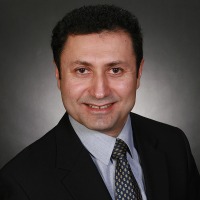
Nearly 50 million people in the U.S. experience tinnitus, making it one of the more-common medical conditions people in the U.S. may have. So common, in fact, that tinnitus even has its own awareness week every February.
Sebahattin Cureoglu, MD, is an ear, nose and throat specialist (otolaryngologist) with University of Minnesota Physicians (M Physicians) who treats adult patients with ear and hearing conditions in addition to rhinitis and sinusitis. He’s also a professor at the University of Minnesota Medical School where his research focuses on hearing loss, middle ear infections and other ear conditions.
Dr. Cureoglu leads one of only three laboratories in the world dedicated to studying human ear pathology, and as part of this lab’s mission, he and his team are helping to identify potential therapies for tinnitus and other ear conditions.
We asked him to share insight on what tinnitus is and how he and teams across the University of Minnesota are working to help patients manage it.
What is tinnitus?
“Tinnitus is a sound perception in the brain or ear without any external source,” Dr. Cureoglu explains, “It can present in one ear or both.”
Dr. Cureoglu notes that it is also important to know that tinnitus is a symptom, not a disease, and that there are two kinds:
- Objective tinnitus, which is tinnitus that can be heard by a physician or an observer
- Subjective, which can only be heard by the person experiencing it
Objective tinnitus may be synchronized with a patient’s heartbeat, another muscle contraction or vibrations in the eardrum. “It is much more rare than subjective tinnitus,” Dr. Cureoglu says.
“Subjective tinnitus is the kind that affects a vast majority of patients, and it’s a phantom sound or pain that is generated by the brain,” Dr. Cureoglu explains, noting that it is often associated with hearing loss.
Part of how subjective tinnitus may work is that the brain may be compensating for silence as a result of hearing loss, according to Dr. Cureoglu. “In the absence of sound, the brain may create the sound sensation many people with tinnitus feel to make up for the lack of sound,” he says.
“Understandably, when patients come to us saying they’re experiencing tinnitus, they’re usually anxious or nervous because they’ve likely heard that it’s untreatable, and they’re very concerned about what it might mean for them,” Dr. Cureoglu says.
“What we want them to understand is that it may not always be possible to fully treat it, but it is always very possible to manage it.”
How to manage tinnitus
For tinnitus management, the first step Dr. Cureoglu works through with his patients is to identify the potential source. “Since tinnitus is a symptom, it’s our job to figure out what the source is and work to treat it accordingly,” he says.
“One of the top things we think about right away is if the tinnitus is accompanied by vertigo or dizziness, vision issues, weakness, numbness or a tingling sensation,” Dr. Cureoglu says, noting that those are concerning signs a doctor should address immediately.
To determine the likely source, a doctor will also usually conduct a hearing test and check the patient’s middle ear pressure. For some additional symptoms, Dr. Cureoglu explains that they might then do magnetic resonance imaging (MRI) or a computerized tomography (CT) scan to further pinpoint the source.
Once they have been able to determine the likely cause of tinnitus, Dr. Cureoglu says doctors will then work with patients to come up with a specific management plan. Depending on what is the most likely source and any triggering factors, a management plan may often include protection and treatment for hearing loss in addition to diet and physical activity modifications, tinnitus masking sound therapy or tinnitus retraining therapy.
“Dehydration, alcohol consumption and smoking, saturated fats and caffeine can all impact how the middle ear may perceive sound,” Dr. Cureoglu says. “Salt, for example, can increase pressure in the ear.”
Managing tinnitus for some patients may necessitate a more multidisciplinary approach, too, according to Dr. Cureoglu. Doctors may refer a patient to a psychologist for cognitive behavioral therapy (CBT), which can help patients rewire their response to tinnitus and help improve any anxiety and sleep-related complications. Engaging an audiologist can help address hearing loss as well.
“The vast majority of my patients come back one month after we put together a management plan, and they say that their symptoms have improved,” Dr. Cureoglu says. “It’s important that we help patients feel confident that their tinnitus can be managed.”
Researching potential treatments for tinnitus
Back in his lab at the U of M Medical School, Dr. Cureoglu and his team have studied thousands of ear tissue samples to help determine different conditions that may lead to tinnitus and identify potential therapeutic methods of treating it.
“Currently, there is a lot of research surrounding potential treatments for tinnitus, especially here at the U of M,” Dr. Cureoglu shares. Studies about potential tinnitus treatments show that the below methods may be able to help tinnitus patients:
- Guided ultrasound therapy
- Noninvasive electromagnetic stimulation
- STEM cell therapy
- Somatic tactile stimulation
“Hubert Lim, one of the U of M’s researchers, is investigating somatic tactical stimulation, which consists of giving a sound to the patient and then giving tactile stimulation to the patient’s tongue for a few hours a day. It’s very cool, promising research, though still in the earlier stages of discovery,” Dr. Cureoglu says.
As he and other researchers continue to identify and develop potential treatments, Dr. Cureoglu emphasizes that tinnitus can still be managed now. He recommends reaching out to a doctor for help, especially if patients are feeling anxious or stressed about tinnitus symptoms.
“We want to help you find the right way to manage it,” Dr. Cureoglu says, “And we’re dedicated to helping find additional ways to treat tinnitus in the future.”
